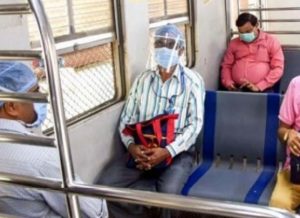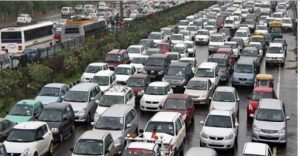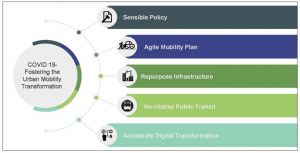Combat tactics necessitated by COVID-19 including social distancing, lockdowns, travel restrictions, and the aftermath resulted in double whammy for the social and economic structure of society. These situations are forcing us towards a complete revamp on the way we conduct ourselves in our day to day socio-economic interactions and personal hygiene. Swift adaptation of work from home, on-line classrooms, e-commerce, tele-medicine etc., have impacted urban mobility with reduced demand. With exception to health workers and their associates, today rest of us think twice before we step out of our homes and explore alternatives to avoid the same.
Changing Urban Mobility Contours
 Mobility demand in urban areas especially personal mobility has undergone substantial change mostly downward. Work, education, shopping and recreation, the main activities necessitating mobility are transformed with rapid adaptation of work from home, on-line classrooms, e-commerce and home entertainment respectively. Also, health and safety mindfulness is changing the travel behaviour with choice of destinations within reduced radius to neighbourhood with shorter travel times and shift to personal mode i.e. car or bike as against use of public transport or shared mobility options. In some cases, shift is observed to walking and non-motorised transport modes in case of short distance commute.
Mobility demand in urban areas especially personal mobility has undergone substantial change mostly downward. Work, education, shopping and recreation, the main activities necessitating mobility are transformed with rapid adaptation of work from home, on-line classrooms, e-commerce and home entertainment respectively. Also, health and safety mindfulness is changing the travel behaviour with choice of destinations within reduced radius to neighbourhood with shorter travel times and shift to personal mode i.e. car or bike as against use of public transport or shared mobility options. In some cases, shift is observed to walking and non-motorised transport modes in case of short distance commute.
A recent survey conducted by TERI revealed that about 35 per cent of respondents are likely to change their mode of transport to private vehicle for work trips post COVID-19. Analogous to this trend, ridership along metro rail and city bus services indicate a steep fall. In Bangalore, the ridership on buses was just 50 percent of its pre-COVID times and Metro saw just 70,000 passengers as against daily ridership of 5 lakh pre-COVID. Delhi metro is no different, with its daily ridership nosediving from 5.7 million (before the lockdown in March), to one million since resuming services in September. Steep increase in private car traffic between pre and post COVID first wave in Hyderabad (Ref. Graphic) also substantiate the findings. Even the ride-hailing firms like Ola and Uber are struggling to regain their pre-COVID ridership levels. Daily active users which is measured as a percentage of the overall user base which is used to be around 6 before March 2020 was not going beyond 4 post opening of offices and few educational institutes during 1st wave.
 Cities, the growth engines of economy are the most impacted due to COVID and as an after effect its mobility contours are undergoing an unprecedented paradigm shift. Although it is too early to portray the true picture of the new normal, emerging trends indicate that, the pandemic shall be leaving permanent scars on the structure of urban mobility systems. While the experts and City authorities are nerve-racking to understand the new normal and preparing their responses, a few insights along with relevant technological interventions are discussed in this article by Venkata Chunduru, Director, India IBI Group that could help them create resilient and sustainable mobility people-Centric solutions.
Cities, the growth engines of economy are the most impacted due to COVID and as an after effect its mobility contours are undergoing an unprecedented paradigm shift. Although it is too early to portray the true picture of the new normal, emerging trends indicate that, the pandemic shall be leaving permanent scars on the structure of urban mobility systems. While the experts and City authorities are nerve-racking to understand the new normal and preparing their responses, a few insights along with relevant technological interventions are discussed in this article by Venkata Chunduru, Director, India IBI Group that could help them create resilient and sustainable mobility people-Centric solutions.
This COVID induced behavioural change has been a double whammy for public transit authorities with shrinking of revenues on one side and rising in operating costs to accommodate new hygiene norms on the other.
 Urban freight scenario too is experiencing demand explosion with Home transforming as a place of stability and security. Consumer spend is shifting towards in-home comforts on account of work from home and need to maintain minimum social contact. Growth in e-commerce industry with approximately 26 per cent growth in order volumes between last quarter of 2020 as against previous year and 95 per cent of this being contributed by Cities confirms the changing contours of the urban mobility. Last mile connectivity demand surge due to home-delivery could add up to the safety, congestion and pollution problems in the path towards recovery.
Urban freight scenario too is experiencing demand explosion with Home transforming as a place of stability and security. Consumer spend is shifting towards in-home comforts on account of work from home and need to maintain minimum social contact. Growth in e-commerce industry with approximately 26 per cent growth in order volumes between last quarter of 2020 as against previous year and 95 per cent of this being contributed by Cities confirms the changing contours of the urban mobility. Last mile connectivity demand surge due to home-delivery could add up to the safety, congestion and pollution problems in the path towards recovery.
With the virus induced radical travel behavioural changes, urban mobility is clearly set out for a transformation. While some of these trends might reverse to a certain degree, what remains as uncertain is the time it might take and the quantum of reversal. With the severe and prolonged economic downturn, the changes could be here to stay for a longer tenure causing structural shift in the urban mobility contours.
Post COVID Urban Mobility Conundrum
Changing urban mobility scenario could pose multi-fold challenges to the authorities in terms of nature, scale and sphere of influence of the changing patterns characterised by the socio-economic distribution of population.
- Changing Trip Patterns due to work from home, increased e-commerce or home deliveries could Flatten the Peak and Spread of Demand Through the Day
- Increased Shift to Private Vehicles shall cause more Strain on Already Stressed Infrastructure roads, parking etc., in addition to increased congestion and safety concerns.
- Increased Adoption of Walking or NMT as preferred mode for short trips Worsening the Safety Scenario due to lack of dedicated walking / cycle tracks and all modes competing for use of same carriageway.
- Reduced Patronage of Public Transit resulting in Revenue Deficit and Increased Operating Costs due to enhanced hygiene compliance for public transit agencies.
- Increased Dependency on Neighbourhood for Daily Needs leading to surge in demand resulting in mushrooming of roadside commercial activity or mobile hawkers and Encroachments to Public Spaces.
- Increased Demand for Fossil Fuels resulting in Increased Pollution and Climate impact.
- Uncertainty of the Future Trends and Lack of Comprehensive and real-time Data on changing trends makes this planning / policy making / regulation a more complex phenomenon

Lessons from the Past
 From Bubonic plague (Black Death) during 1343 to 1356 CE to HIV, SARS and Swine flu of 21st century, mankind has experienced pandemics and consequential collapse of the economic and social system. Study of them definitely gives us understanding of the post pandemic scenarios and lessons to cope-up with the same. Experts have analysed post pandemic trends to derive insights and design solutions for post COVID scenarios. Amongst many three key insights are worth mention.
From Bubonic plague (Black Death) during 1343 to 1356 CE to HIV, SARS and Swine flu of 21st century, mankind has experienced pandemics and consequential collapse of the economic and social system. Study of them definitely gives us understanding of the post pandemic scenarios and lessons to cope-up with the same. Experts have analysed post pandemic trends to derive insights and design solutions for post COVID scenarios. Amongst many three key insights are worth mention.
- Post-Pandemic people spending was found to rise especially with those in higher income segment. Correlating this to mobility especially on trends on shift to private vehicle implies that the sales of cars and two-wheelers might go up. Hence if this surge is directed in right direction through policy interventions such as subsidies on electric vehicles one can push the achievement of electric vehicle mission
 Pandemics historically accelerated adoption of technology which results in reduced reliance on humans which more prone to such pandemics. COVID-19 has been catalysing digital transformation across businesses and fundamentally redefine the overall business landscape. Adopting this in mobility arena, creating enabling frameworks for multi-modal integration and complete penetration of digital (contact-less) payments across mobility players to give commuters a seamless experience could be truly transformational.
Pandemics historically accelerated adoption of technology which results in reduced reliance on humans which more prone to such pandemics. COVID-19 has been catalysing digital transformation across businesses and fundamentally redefine the overall business landscape. Adopting this in mobility arena, creating enabling frameworks for multi-modal integration and complete penetration of digital (contact-less) payments across mobility players to give commuters a seamless experience could be truly transformational.- Pandemics are found to expose and accelerate pre-existing social inequalities leading to social unrest. Designing and implementing right interventions that promotes partnership pivoted around social inclusivity shall prevent such unrest and always shaped better future. As an example, public and private sector mobility players such as ride-hailing, vehicle rentals, delivery services and transit agencies while ensuring safety of commuters and workers are if can come together to facilitate access to essential services such as food, groceries, medicines and supporting unsheltered and vulnerable sections of society.
COVID 19 – Fostering the Urban Mobility Transformation
Whether COVID or otherwise the goal of urban mobility solution shall remain unaltered i.e., providing Sustainable, Equitable, Efficient, Convenient, Safe and Resilient system for the movement of passengers and goods in the city. Just that the pandemic is forcing us to strategize, re-align and hasten our efforts to achieve these goals while making the case stronger for inclusivity, and resilience.
COVID has resulted in behavioural changes. Interventions shall be designed with an objective to sustain certain behaviours with enablers, discourage certain behaviours through regulation/ enforcement and induce new behaviours through policy / promotion.
Key action for achieving the above in the post-COVID world are summarised in to five key segments.
Sensible Policy
Social inclusion shall be the guiding principle in designing the policy interventions which shall lay a strong foundation for a post-COVID world. Applying this for urban
mobility, it is essential to formulate the policies and systems which promotes social inclusion will also make it more sustainable. Few such steps could be to ensure prioritising public transport investments and keep it accessible and affordable to economically weaker sections of society. Ensuring equity in allocation public spaces encourage and facilitate those walking, using bicycles are safely able Commute. Policy interventions shall designed to,
- promote green modes such as cycles, e-scooters/e-vehicles including enabling provisions for innovative business models to finance and operate public bike sharing/ride hailing solutions
- promote shift to electric vehicles through incentives such as purchase-price subsidies and tax exemptions to the industries involved in production of electric vehicles.
- discourage use of private cars by imposing congestion pricing and promoting use of public transport for long distance commute.
Agile Mobility Plan
- Cities should develop a mobility plan agile and responsive to evolving mobility scenario and aligned with the population needs, characteristics and funding capacity. Different priorities to be considered by authorities in shaping up the plan shall include
- re – allocation urban public spaces/land-use to accommodate the rising demand for neighbourhood markets
- re-allocation of streetscape to include equitable distribution to walking, cycling, public transport, IPT and personal travel modes.
- re-allocation of parking spaces for emerging needs such as electric vehicle charging infrastructure
Repurpose Infrastructure
Curb side enforcements shall be regulated to sustain the shift towards walking and cycling. Parking facilities near transit terminals, bus stops and community marketplaces / commercial hubs shall be prioritised for public bike sharing, shared mobility service providers and electric vehicles including charging facilities. Also, to prevent encroachment, parking shall be facilitated for those home-delivery service providers near the outlets.
Road-side spaces can be re-purposed and regulated in such a way that the same can be used by street / mobile hawkers during certain period of the day and other times its available for other purposes.
Re-vitalise Public Transit
Public transport agencies are the worst hit due to pandemic and re-gaining customer trust and building the operational resilience shall be the highest priority.
- On high priority basis public transport service shall be made completely contactless and conductor less by introduction of digital payments and use of smart cards to board/alight buses.
- Best in class measures shall be deployed to ensure secure and safe environment for passengers and drivers. Bus designs shall be modified with glass/flexi partition between the driver and the passenger area to safe-guard drivers from infection. Apart from having systems to enforce physical distancing and systems for health checks at entry points, Buses and bus stops/terminals shall thoroughly and regularly sanitized to keep the infection at bay.
- To make the services more viable and cost-effective, on-demand services especially buses shall be deployed on major trunk routes complimented by shared/micro mobility services for last mile connectivity or interior routes from private service providers.
- In addition to the above, systems shall be deployed for sharing real-time information on service availability, schedules arrivals and fare to commuters at all touch points including their mobile phones.
- Since public transport forms core of any city’s mobility system, the improvements such as replacement of old fleet, EV adoption, digital reforms and staff training and re-skilling shall have to be prioritised and ensured allocation of adequate funding.
Accelerate Digital Transformation
Historically pandemics have accelerated digital transformations and COVID cannot be any different. While there are discrete technology-based interventions that required and can be adopted at respective segments of mobility such as digital payments, asset management, curb-side regulation, enforcement etc., desperate need of the hour is to have a, comprehensive and integrated mobility platform based on real-time data, powered by robust algorithms and which makes insights easily accessible to all stakeholders at all times. COVID crisis shall be used to catalyse this transformation by uniting and channelising efforts of all stakeholders.
- Mobility Data Lake shall be conceptualised and deployed where data from all mobility providers in the city both public and private, passenger and goods can be aggregated and shared between the stakeholders. This shall be under the ownership of a single unified public authority to ensure enforceability, accessibility, and transparency. This necessitates, development and deployment of data-sharing policies, integrating the passenger information, digital payments, asset, people and process performance, enforcement etc. which constitute key requirements for a MaaS (Mobility as a Service) platform. This also necessitates development of standards and protocols for data collection and bidirectional data exchange, including underlying principles and ethics and mechanisms for value sharing. This can help understand the emerging trends especially post pandemics like current scenario and adjust the policy, regulatory and financial interventions to achieve the mobility goals. Also, it meets the data needs of mobility service providers, IT system integrators/ operators, ticketing and payment providers, and insurance companies.
- Use of Advanced Technologies Public and private mobility players shall engage in active technological collaborations to maximize the value they can create for the system by use of advanced technologies ranging from artificial intelligence and machine learning (AI/ ML)- enabled data analytics to blockchain and quantum computing.
- Mobility as a service (MaaS) is the most appropriate transformation the urban mobility would need in post-COVID era. MaaS unites private and public transportation sectors to create a seamless mobility “ecosystem” centered on end user needs. The purpose of MaaS is to use detailed historic and real-time user and location data to help people meet shifting mobility needs and solve challenging trip situations. For users, MaaS simplifies the complexities of urban mobility via a single application that provides access to multimodal transportation and a single payment channel rather than multiple platforms. MaaS could also result in greater comfort and an increased sense of rider safety gained via the possibility of filtered transport options. For mobility service providers, MaaS brings a new business model and benefits including new sales opportunities, simplified payment management, and access to comprehensive travel patterns, which can help meet consumer demands. For public authorities MaaS can helps in creating and regulating safe mobility options especially in post-COVID scenario as it is based on data-based (usage and need) transportation models.
Technology can be the key enabler and a catalyst in the journey of transformation of urban mobility ecosystem into a people centric, sustainable and resilient system.

Re-Prioritising Public Investments/Funding
With already limited by its availability and heavy diversion to public health in current scenario, wisdom guides us to re-prioritise the available public funds by investing in low intensive and high return segments. Some of the priorities include
- Creating / enhancing the street infrastructure for enabling safe walking and cycling
- Creating parking spaces for micro mobility systems including public bike sharing, e-scooters etc.,
- Investments in public transport for rebuilding the commuter trust and building operational resilience including digital payments and improving hygiene
- Incentivising electric mobility and shared mobility and setting -up of enabling charging infrastructure
- Digital transformation initiatives such as MaaS platform as discussed above.
- Other initiatives which can provide stimulus to economic revival.
Collaboration and Social Partnerships
With changing commuter priorities and mobility patterns a balanced approach is required to share the available resources between private cars, public transportation, and new mobility
services to foster a sustainable urban ecosystem. This can only be achieved through a data-driven partnership between public authorities and private mobility players (Maas).
All key stakeholders including City Planners, Municipal Authorities, Public Transport Agencies, Mobility Solution Providers such as ride hail agencies and e-commerce agencies, Funding Agencies, Private Sector, Consultants/Experts, Technology Service Providers etc., should join hands to collaborate and commit for development and timely execution of a unified action plan towards achieving the mobility goals.
Engaging new private players is critical to meet the demands of the post COVID mobility era in a timely manner. Private service providers could be effective in quick roll-out of health/hygiene infrastructure and protocols, servicing the socially critical and long-return segments of mobility such as last mile connectivity to mass transit, micro-mobility services (public bike sharing, e-scooters) bringing cost-effective financing for cost intensive public infrastructure projects, deployment of technological interventions.
Not just the passenger mobility but urban freight mobility also demands constructive engagement between public and private stakeholders to make the engagement efficient and mutually complimenting. Truck fleets would need new safety and preventive protocols for the transportation of perishable and non-perishable goods and commodities where the
companies will take extra efforts to sensitize their staff and sanitize their products being dispatched, stored, and transported from one place to another. Public authorities shall facilitate the process by building infrastructure and setting up enforcement system to monitor the compliance to regulations
 TrafficInfraTech Magazine Linking People Places & Progress
TrafficInfraTech Magazine Linking People Places & Progress